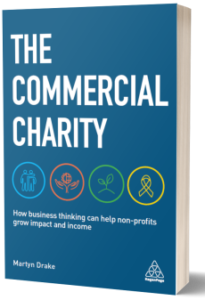
Because, to paraphrase Malvolio, some charities were born commercial, some have become commercial, most of the rest are now having commerciality thrust upon them.
Take that first category: born commercial.
The National Trust is one of the UK’s largest and best-known charities and has operated on an almost exclusively commercial model since it was founded in 1895. It does commerce brilliantly, and nobody has a moral problem with that. But the same is true for literally tens of thousands of other charities.
And not just those who call themselves social enterprises or operate chains of charity shops. Scout and guide troops, youth hostels, sports and community clubs, theatre and arts organisations; the commercially powered, registered charities, that form the core of our social and cultural landscape.
Some of them might also fundraise, apply for grants, be fortunate enough to receive the occasional legacy, but their operating model has always been predicated, from their very conception, on the fact that people would be willing to pay for what they provide.
Other charities have had to become more commercial. Particularly those providing services into the public sector.
While they may have begun decades ago with outsourcing agreements or grants, that later transitioned into contracts (often quite lucrative ones) they’ve now found themselves, after years of austerity, embroiled in ruthlessly competitive tender processes that, even if they win, might result in fees that don’t even come close to their cost of delivery.
There are plenty of charities who’ve experienced this shift, yet have been incredibly slow, sometimes catastrophically so, in developing the sharp commercial skills and behaviours they need to work in that emerging context.
For all these organisations, commercial understanding, the insights, attitudes, and skills of commerce, can no longer be seen as some kind of dark-arts capability bolted on to the side of the finance team that we just have to live with.
They are fundamental to these charities’ futures.
And more to the point, they need to be seen that way, by everyone, because if they aren’t, what we get is a constant and increasing tension between the people who are seen as “needing to make the contracts add up”, and the people who “just want to be allowed to do good work”.
A tension that, as the reserves steadily evaporate, ends up landing on the desk of the executives and CEO.
And it’s that wider lack of commercial understanding which means their anguished, often quite lonely decisions, will probably come two years too late and, irrespective of their inarguable rationale, will still alienate half their employees and stakeholders.
Commercial understanding is key, not just to making these decisions faster and better, but for getting them to land properly once they’re made.
But it’s in that third group, I think, where the biggest opportunity sits – with those who are now having commerce thrust upon them.
We all know the refrain: traditional funding streams are drying up, need is growing, charities need to diversify their income. And by “diversify income” we generally mean “find new ways to earn it”.
These are the conversations I love most of all.
Because when I work with charities on this stuff, I’m constantly surprised by the range of ideas and the value they could unlock, in both income and impact. But as I also tell every charity leader who comes to ask me about it, commercial understanding is the bedrock on which everything else has to be built.
You need the people who will lead it to be commercially astute and entrepreneurially minded.
But you also need the wider organisation to buy in to the fact this stuff isn’t just important, it’s also the right thing to do for you and your cause.
Get that first one nailed and your team will find ways to make most of the ideas work. Get the second one nailed and those ideas will be able to scale.
Commerce has enormous potential for charities. All we need is for our people to understand it better. The thing is, it’s not rocket science. I mean, if I can teach this stuff, it really can’t be that hard.
And on that note, I’ll end with huge thanks to the dozens of voluntary adoption agencies who welcomed me to speak to them about this last week, and for their lovely note afterwards: “Your session was truly thought-provoking, and we’ve already had so much positive feedback about it. We could have played it safe with the keynote but I’m so glad we didn’t – your session was suitably challenging and highly appropriate for the times we are in.” Alice Talbot, Director of Strategy and Policy, Consortium of Voluntary Adoption Agencies
You are the people who make sharing this stuff worthwhile.
